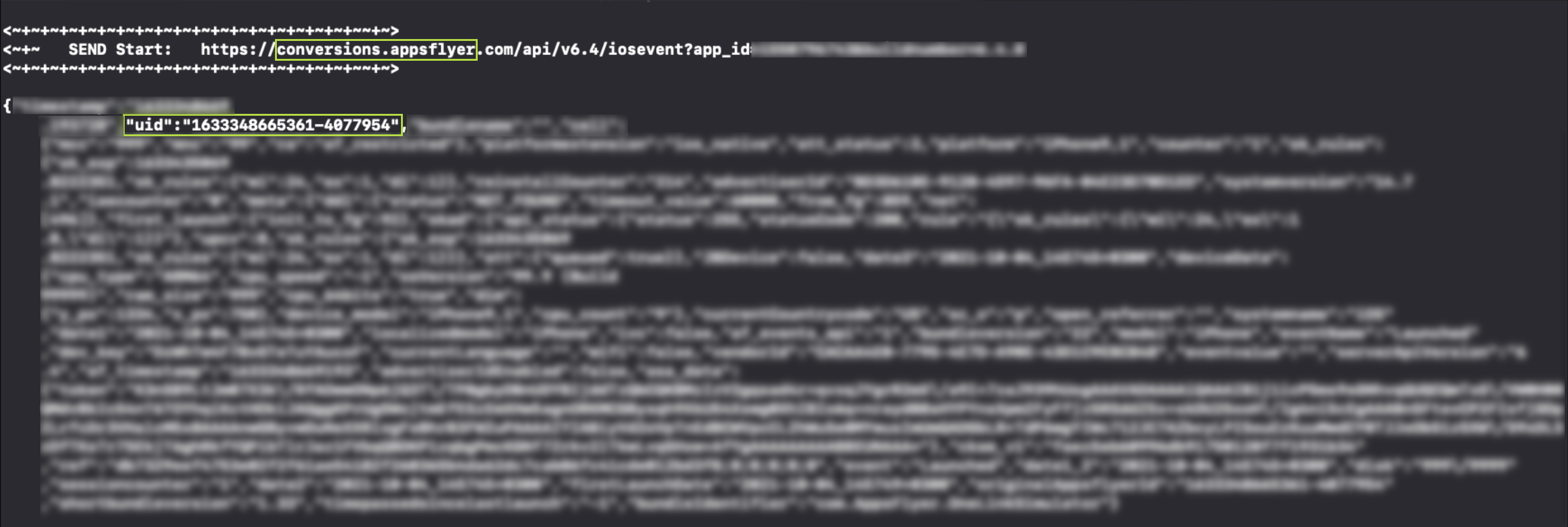Manual testing
Note
We recommend using our SDK wizard integration tool for testing
To successfully complete the test in this document, you must:
Test iOS SDK integration
The test consists of:
- Simulating an ad click and installing the app:
- If you implement ATT, follow these instructions.
- If you don't implement ATT, follow these instructions.
- Inspection the conversion data of the install.
Apps that implement ATT
Follow these instructions if you implement App Tracking Transparency (ATT) in your app.
Attribution will occur via ID matching if the following conditions are met:
- The attribution link contains the
idfaparameter - ATT is implemented and:
requestTrackingAuthorizationis called beforestart(by utilizingwaitForATTUserAuthorization)- User consent is given.
Step 1: Simulate ad click
Simulate an ad click via an attribution link. Structure the attribution link as follows:
https://app.appsflyer.com/<app_id>?pid=<media_source>
&idfa=<registered_device_idfa>
Where:
app_idis your AppsFlyer app ID (includingidsuffix)pidis the media source to which the install should be attributed toidfais the registered device's IDFA.
Example
If your app ID is id123456789, the attribution link might look like this:
https://app.appsflyer.com/id123456789?pid=conversionTest1&idfa=1A2B3C4D-9128-4597-1234-
04E23D654321
Step 2: Install the app
Enable debug mode and install the app on a registered test device.
Step 3: Execute test
Proceed to inspect conversion data.
Apps that don't implement ATT
Step 1: Simulate an ad click
Simulate an ad click via an attribution link. Structure the attribution link as follows:
https://app.appsflyer.com/<app_id>?pid=<media_source>
Where:
app_idis your AppsFlyer app ID (includingidprefix)pidis the media source to which the install should be attributed to.
Example
If your app ID is id123456789, the attribution link might look like this:
https://app.appsflyer.com/id123456789?pid=conversionTest1
Step 2: Install the app
Enable debug mode and install the app on any device–since the IDFA used to register the device isn't available, device registration has no effect in this case.
Step 3: Execute test
Proceed to inspect conversion data.
Tip
More often than not, tests using attribution links are performed more than once. That's why it's recommended to use one of the attribution parameters to "version" your tests–it makes it easier to understand which link triggered which conversion.
In the above example, the value of
pidisconversionTest1. In consecutive tests, increment the value ofpidtoconversionTest2,conversionTest3, and so on.
Inspect conversion data
After simulating an ad click and installing the app, follow these steps to inspect the install's conversion data.
Step 1: Retrieve install UID
Once the app is installed, In the Xcode terminal, search for conversions.appsflyer. Look for the uid parameter and copy its value.

Step 2: Inspect conversion data
Go to the conversion data test API and fill in the required fields:
app-id: Your app IDdevice_id: paste the value ofuidfrom step 1.devkey- Application's devkey. Learn here how to get it.
Then, click Try it! to execute the test.
Expected results
If ATT is implemented and user consent is given, the result is a 200 response similar to (truncated for readability):
{
...
"af_status" = "Non-organic";
...
"match_type" = id_matching;
"media_source" = conversionTest1;
...
}
Otherwise, attribution occurs probabilistically and the result is a 200 response similar to (truncated for readability):
{
...
"af_status" = "Non-organic";
...
"match_type" = probabilistic;
"media_source" = conversionTest1;
...
}
If the install isn't attributed, the result is a 200 response with the following payload:
{
"af_message" = "organic install";
"af_status" = Organic;
"install_time" = "2021-08-23 06:59:51.194";
"is_first_launch" = 1;
}
Note
It might take up to 30 minutes for installs to appear in the dashboard.
Note
It might take up to 30 minutes for the install to appear in the dashboard.
Updated about 1 year ago